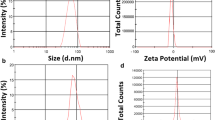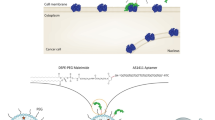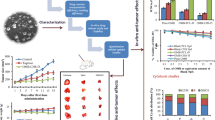Abstract
Nowadays, nanoparticle-based combination therapy has been emerging as huge innovation in cancer treatment. Here, we studied the effect of Stattic (STAT3 inhibitor) loaded in nanostructured lipid carriers (NLCs) on enhancing the efficacy, cytotoxicity, and induction of apoptosis of doxorubicin in B16F10 mouse melanoma cancer cell. The evaluation of Stattic-loaded NLCs has been done in terms of zeta potential, particle size, scanning electron microscope (SEM), and cellular uptake. MTT assay was applied to evaluate the cell proliferation. Apoptotic cell death and identification of early and late apoptosis were assessed by DAPI staining and Annexin V/PI staining, respectively. Real-time RT-PCR was applied to measure the effects of doxorubicin and/or Stattic on key apoptotic genes such as Bad, Survivin, HIF1, and STAT3. The Stattic formulated into NLCs shown mean particle size of 56 ± 7 nm which was confirmed by SEM. The IC50 values for Stattic and doxorubicin were 2.95 ± 0.52 μM and 1.21 ± 0.36 μM, respectively. Stattic-loaded NLCs diminished percent of cell proliferation from 68 ± 6.8 to 54 ± 3.7% (p < 0.05). Combinational treatment of the cells with Stattic-loaded nanoparticles and doxorubicin give rise to a significant increase in the percentage of apoptosis (p < 0.05). The study of gene expression profile has shown a remarkable decrease in anti-apoptotic gene, Survivin, along with smooth decline in HIF1 as angiogenesis intermediator and increase in Bad mRNA levels. Our results recommend that NLCs as novel technology have potent strategy to augment efficacy of current chemotherapeutic agent in melanoma cancer cells.






Similar content being viewed by others
References
Ali Z, Yousaf N, Larkin J (2013) Melanoma epidemiology, biology and prognosis. EJC Suppl 11:81–91
Batus M, Waheed S, Ruby C, Petersen L, Bines SD, Kaufman HL (2013) Optimal management of metastatic melanoma: current strategies and future directions. Am J Clin Dermatol 14:179–194
Berwick M, Buller DB, Cust A, Gallagher R, Lee TK, Meyskens F, Pandey S, Thomas NE, Veierød MB, Ward S (2016) Melanoma epidemiology and prevention. Springer, Melanoma., pp 17–49
Bharadwaj U, Kasembeli MM, Tweardy DJ (2016) STAT3 inhibitors in cancer: a comprehensive update. STAT Inhibitors in Cancer. Humana Press, Cham, pp 95–161
Cao H-H, Chu J-H, Kwan H-Y, Su T, Yu H, Cheng C-Y, Fu X-Q, Guo H, Li T, Tse AK-W (2016) Inhibition of the STAT3 signaling pathway contributes to apigenin-mediated anti-metastatic effect in melanoma. Sci Rep 6:21731
Carpenter RL, Lo H-W (2014) STAT3 target genes relevant to human cancers. Cancers 6:897–925
Cohen-Solal KA, Kaufman HL, Lasfar A (2018) Transcription factors as critical players in melanoma invasiveness, drug resistance, and opportunities for therapeutic drug development. Pigment Cell Melanoma Res 31:241–252
Domingues B, Lopes JM, Soares P, Pópulo H (2018) Melanoma treatment in review. Immuno Targets Therapy 7:35–49
Elliott AM, Al-Hajj MA (2009) ABCB8 mediates doxorubicin resistance in melanoma cells by protecting the mitochondrial genome. Mol Cancer Res 7:79–87
Ferreira A, Cunha-Oliveira T, Simões RF, Carvalho FS, Burgeiro A, Nordgren K, Wallace KB, Oliveira PJ (2017) Altered mitochondrial epigenetics associated with subchronic doxorubicin cardiotoxicity. Toxicology 390:63–73
Floyd J, Mirza I, Sachs B, Perry MC (2006) Hepatotoxicity of chemotherapy. Semin Oncol 33(1):50–67
Hortobagyi G (1997) Anthracyclines in the treatment of cancer. Drugs 54:1–7
Huang Y-H, Vakili MR, Molavi O, Morrissey Y, Wu C, Paiva I, Soleimani AH, Sanaee F, Lavasanifar A, Lai R (2019) Decoration of anti-CD38 on nanoparticles carrying a STAT3 inhibitor can improve the therapeutic efficacy against myeloma. Cancers 11:248
Injac R, Strukelj B (2008) Recent advances in protection against doxorubicin-induced toxicity. Technol Cancer Res Treat 7:497–516
Karimkhani C, Green AC, Nijsten T, Weinstock M, Dellavalle RP, Naghavi M, Fitzmaurice C (2017) The global burden of melanoma: results from the global burden of disease study 2015. Br J Dermatol 177:134–140
Kortylewski M, Jove R, Yu H (2005) Targeting STAT3 affects melanoma on multiple fronts. Cancer Metastasis Rev 24:315–327
Liu F, Cao J, Wu J, Sullivan K, Shen J, Ryu B, Xu Z, Wei W, Cui R (2013) Stat3-targeted therapies overcome the acquired resistance to vemurafenib in melanomas. J Investig Dermatol 133:2041–2049
Loh C-Y, Arya A, Naema AF, Wong WF, Sethi G, Looi CY (2019) Signal transducer and activator of transcription (stats) proteins in cancer and inflammation: functions and therapeutic implication. Front Oncol 9:48
Luo Q, Zhao J, Zhang X, Pan W (2011) Nanostructured lipid carrier (NLC) coated with chitosan oligosaccharides and its potential use in ocular drug delivery system. Int J Pharm 403:185–191
Mahmoudi S, Ghorbani M, Sabzichi M, Ramezani F, Hamishehkar H, Samadi N (2019) Targeted hyaluronic acid-based lipid nanoparticle for apigenin delivery to induce Nrf2-dependent apoptosis in lung cancer cells. J Drug Deliv Sci Technol 49:268–276
Maroufi NF, Vahedian V, Mazrakhondi SAM, Kooti W, Khiavy HA, Bazzaz R, Ramezani F, Pirouzpanah SM, Ghorbani M, Akbarzadeh M, Hajipour H, Ghanbarzadeh S, Hajipour H (2020) Sensitization of MDA-MBA231 breast cancer cell to docetaxel by myricetin loaded into biocompatible lipid nanoparticles via sub-G1 cell cycle arrest mechanism. Naunyn Schmiedeberg’s Arch Pharmacol 393(1):1–11
Matthews NH, Li W-Q, Qureshi AA, Weinstock MA, Cho E (2017) Epidemiology of melanoma. Exon Publications 30:3–22
McGowan JV, Chung R, Maulik A, Piotrowska I, Walker JM, Yellon DM (2017) Anthracycline chemotherapy and cardiotoxicity. Cardiovasc Drugs Ther 31:63–75
Mohammadian J, Sabzichi M, Molavi O, Shanehbandi D, Samadi N (2016) Combined treatment with stattic and docetaxel alters the Bax/Bcl-2 gene expression ratio in human prostate cancer cells. Asian Pac J Cancer Prev 17:5031
Mokhtari RB, Homayouni TS, Baluch N, Morgatskaya E, Kumar S, Das B, Yeger H (2017) Combination therapy in combating cancer. Oncotarget 8:38022–38043
Ng R, Better N, Green MD (2006) Anticancer agents and cardiotoxicity. Semin Oncol 33(1):2–14
Pan Y, Zhou F, Zhang R, Claret FX (2013) Stat3 inhibitor Stattic exhibits potent antitumor activity and induces chemo-and radio-sensitivity in nasopharyngeal carcinoma. PLoS One 8:e54565
Panda AK, Chakraborty D, Sarkar I, Khan T, Sa G (2017) New insights into therapeutic activity and anticancer properties of curcumin. J Exp Pharmacol 9:31–45
Park H-K, Lee J-E, Lim J, Jo D-E, Park S-A, Suh P-G, Kang BH (2014) Combination treatment with doxorubicin and gamitrinib synergistically augments anticancer activity through enhanced activation of Bim. BMC Cancer 14:431
Pastorino F, Mumbengegwi DR, Ribatti D, Ponzoni M, Allen TM (2008) Increase of therapeutic effects by treating melanoma with targeted combinations of c-myc antisense and doxorubicin. J Control Release 126:85–94
Pindiprolu SKS, Chintamaneni PK, Krishnamurthy PT, Ratna Sree Ganapathineedi K (2019) Formulation-optimization of solid lipid nanocarrier system of STAT3 inhibitor to improve its activity in triple negative breast cancer cells. Drug Dev Ind Pharm 45:304–313
Poli G, Gelain A, Porta F, Asai A, Martinelli A, Tuccinardi T (2016) Identification of a new STAT3 dimerization inhibitor through a pharmacophore-based virtual screening approach. J Enzyme Tnhibit Med Chem 31:1011–1017
Qin J-J, Yan L, Zhang J, Zhang W-D (2019) STAT3 as a potential therapeutic target in triple negative breast cancer: a systematic review. J Exp Clin Cancer Res 38:195
Raeisi S, Chavoshi H, Mohammadi M, Ghorbani M, Sabzichi M, Ramezani F (2019) Naringenin-loaded nano-structured lipid carrier fortifies oxaliplatin-dependent apoptosis in HT-29 cell line. Process Biochem 83:168–175
Sabzichi M, Ramezani M, Mohammadian J, Ghorbani M, Mardomi A, Najafipour F, Mehdizadeh A (2019) The synergistic impact of quinacrine on cell cycle and anti-invasiveness behaviors of doxorubicin in MDA-MB-231 breast cancer cells. Process Biochem 81:175–181
Schust J, Sperl B, Hollis A, Mayer TU, Berg T (2006) Stattic: a small-molecule inhibitor of STAT3 activation and dimerization. Chem Biol 13:1235–1242
Siveen KS, Sikka S, Surana R, Dai X, Zhang J, Kumar AP, Tan BK, Sethi G, Bishayee A (2014) Targeting the STAT3 signaling pathway in cancer: role of synthetic and natural inhibitors. Biochim Biophys Acta 1845:136–154
Tajmohammadi I, Mohammadian J, Sabzichi M, Mahmuodi S, Ramezani M, Aghajani M, Ramezani F (2019) Identification of Nrf2/STAT3 axis in induction of apoptosis through sub-G 1 cell cycle arrest mechanism in HT-29 colon cancer cells. J Cell Biochem 120:14035–14043
Tewey K, Rowe T, Yang L, Halligan B, Liu L-F (1984) Adriamycin-induced DNA damage mediated by mammalian DNA topoisomerase II. Science 226:466–468
Thompson JF, Scolyer RA, Kefford RF (2005) Cutaneous melanoma. Lancet 365:687–701
Tucker MA (2009) Melanoma epidemiology. Hematol Oncol Clin North Am 23:383–395
van Zeijl M, Van den Eertwegh A, Haanen J, Wouters M (2017) (Neo) adjuvant systemic therapy for melanoma. Eur J Surg Oncol (EJSO) 43:534–543
Vermes I, Haanen C, Steffens-Nakken H, Reutellingsperger C (1995) A novel assay for apoptosis flow cytometric detection of phosphatidylserine expression on early apoptotic cells using fluorescein labelled annexin V. J Immunol Methods 184:39–51
Wilson MA, Schuchter LM (2016) Chemotherapy for melanoma. Springer, Melanoma, pp 209–229
Xie T-x, Wei D, Liu M, Gao AC, Ali-Osman F, Sawaya R, Huang S (2004) Stat3 activation regulates the expression of matrix metalloproteinase-2 and tumor invasion and metastasis. Oncogene 23:3550–3560
Zhang H-F, Lai R (2014) STAT3 in cancer—friend or foe? Cancers 6:1408–1440
Funding
The authors received support from the “Drug Applied Research Center, IR.TBZMED.REC. 1396.308.”
Author information
Authors and Affiliations
Contributions
J.M and SH.M had the main contribution in conception and design and are involved in the performance of experiments, data analysis, and interpretation. P.P manuscript writing and editing and revision; M.P and F.S are involved in the data analysis and manuscript writing; N.F are involved in some molecular experiments; N.S and M.S. are involved in the performance of all experiments. We stated that our team did not use a paper mill and performed all experiments in-house.
Corresponding authors
Ethics declarations
Conflict of interest
The authors declare that they have no conflict of interest.
Additional information
Publisher’s note
Springer Nature remains neutral with regard to jurisdictional claims in published maps and institutional affiliations.
Electronic supplementary material
ESM 1
(DOC 4523 kb)
Rights and permissions
About this article
Cite this article
Mohammadian, J., Mahmoudi, S., Pourmohammad, P. et al. Formulation of Stattic as STAT3 inhibitor in nanostructured lipid carriers (NLCs) enhances efficacy of doxorubicin in melanoma cancer cells. Naunyn-Schmiedeberg's Arch Pharmacol 393, 2315–2323 (2020). https://doi.org/10.1007/s00210-020-01942-x
Received:
Accepted:
Published:
Issue Date:
DOI: https://doi.org/10.1007/s00210-020-01942-x




